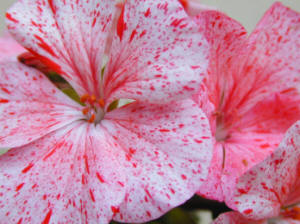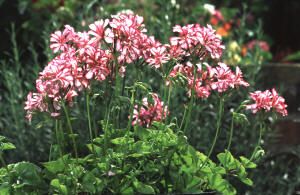Geranium Cuttings - How to take Geranium Cuttings.
Whilst the propagation of Geraniums (Pelargoniums) is increasingly being done by seed sowing, the traditional way of taking cuttings of Geraniums is a good way of ensuring that you get a supply of plants which are in all ways identical to the parent. Taking Geranium Cuttings is a cost effective way to ensure more plants, though growing geraniums from seed is also an option.
This is not the case with saved seed where the young seedlings are often inferior, and not always true to type. Taking geranium cuttings ensures that your new plant will be the same as the parent.
In this section we are talking of the plants that are commonly called Geraniums - but are in reality Pelargoniums. This method of propagation does not apply to the true hardy geraniums which are normally found in herbaceous borders and other permanent year- round planting schemes.
The Zonal Pelargoniums - seen left - and the Ivy Leaf Pelargoniums - seen below left - are the the commonly named Geraniums that are normally sold in garden centres during the late spring and early summer bedding plant season. As with most bedding plants, they are not frost hardy, so can either be disposed of at the end of the summer flowering period, or dug up and over-wintered in a cool frost free shed or greenhouse.

There are another group of Pelargoniums - increasingly popular known as Regal Pelargoniums. These do best as indoor plants though they are increasingly being sold as bedding plants. This group is normally known by its proper name - Regal Pelargoniums, rather than Regal Geraniums!
Any of these three Pelargoniums - Geraniums - can be propagated by either softwood cuttings or semi-ripe cuttings.
 Cuttings can be taken over a long period of time - depending upon
whether you can bring them into growth in a warm greenhouse in the
spring. Otherwise, any time during the normal growing season. Being
softwood cuttings early in the season or semi-ripe cuttings later in the
season. It is also possible to take softwood cuttings of Geraniums later
in the season.
Cuttings can be taken over a long period of time - depending upon
whether you can bring them into growth in a warm greenhouse in the
spring. Otherwise, any time during the normal growing season. Being
softwood cuttings early in the season or semi-ripe cuttings later in the
season. It is also possible to take softwood cuttings of Geraniums later
in the season.
Late Summer Cuttings of Geraniums
Late Summer is the traditional time for taking cuttings from Geraniums - either in late August or in September before the frosts and as the old plants are being lifted either for the compost heap, or to be potted up and bought indoors for the winter.
It is possible to obtain both semi ripe cuttings and softwood cuttings at this time. the traditional way of taking softwood cuttings is the better, and more likely to succeed.
A good batch of geranium cuttings in small peat pots. These ensure that
there is little root disturbance to the geranium cuttings when they are
either potted up or planted out into window boxes or garden.
The best cuttings - found on the side of the plants, are those which have not yet flowered, or are simply showing a flower bud which can be rubbed off. Tip cuttings are also suitable - preferably from un-flowered shoots.
The cuttings should be taken by cutting the shoot from the Geranium near to the main stem. They can then be trimmed to a suitable size - which is normally around 4in long - but may be smaller - depending upon the variety of Geranium.
The geranium cutting should be prepared after removing from the parent plant, by making a clean cut with a sharp knife, just below a leaf joint. The lower leaves of the cutting should be removed - leaving just a pair of full leaves at the top of the cutting. make sure that any small flower buds are removed.
Before inserting into either individual small peat pots or deep seed trays, the geranium cuttings can either be plunged in a container of made-up fungicide or alternatively, drenched with fungicide one inserted into the compost.
Hormone rooting powder will help, but is not essential.
An open-textured multi-purpose compost is suitable, and better if Vermiculite or Perlite is added making a 50/50 mix. Sharp Washed sand will also be suitable. Don't force the cuttings into the compost, but ease them in after a suitable hole has be made with a dibber. Then gently firm the compost around the geranium cutting.
Geraniums can also be rooted in small propagating gel pots. I have heard success stories of geraniums being rooted in a made-up mixture of wallpaper paste gel!
If geranium cuttings are placed in individual small pots, they can be stood in tray or propagator for the rooting process. A heated propagator will ensure quicker rooting, but the cutting can simply be placed on a light widow sill, where rooting will probably take place in 4 - 6 weeks. If not in a covered propagator, then make sure that the cuttings are covered - and airtight - with a light clear polythene sheet. A freezer bag is suitable for this! Avoid direct sunlight, though dappled sunlight will not cause problems. If in a greenhouse where the light intensity is more, then a thin milky white light polythene sheet should be used.
As an alternative to placing into individual pots, the geranium cuttings can be inserted into a deep seed tray - around twenty to a full sized tray, and also covered with a polythene bag.
Inspect the cuttings regularly, and remove all yellowing leaves that fall (It happens - especially to the bottom leaves). Keep a close watch for the Blackleg fungus - easily recognised in that the lower part of the stem literally turns black. If found, remove the affected cuttings and dispose.
Aftercare of Rooted Geranium Cuttings.
- Once the Geranium cuttings have rooted, they can be grown on through the winter in individual pots - or left in their rooting containers until February and then potted up.
- Keep in a cool place but frost free and plenty of light through the winter months. The cuttings compost should be kept quite dry throughout the winter.
- Regular inspection for disease or greenfly that like to over-winter on geranium Cuttings.
- No feeding, until the geraniums are bought into growth with gently heat in the early spring. Thereafter, a weak liquid feed - once a week - will bring the plants on quite well.
- Larger rooted cuttings can be potted on into 4-6in pots, to be grown on to large plants ready for planting out after frosts have finished in late spring /early summer.
See also | Taking Fuchsia Cuttings
Best Selling Gardening Products
Popular Gardening Sections

Problems
Identify Weeds in The Garden - How to deal with weeds. Diseases and Pest which harm your garden and plants, learn how to prevent, deter and erradicate your garden problems.
Garden Problems
Pruning
Pruning Guide. Shrubs flower better with correct pruning. Many illustrations and examples of what to do - and when. Includes evergreens, roses, flowering shrubs, spring flowering shrubs and pruning for stem effect. This is our most viewed and comprehensive section,
Pruning
Gardening Businesses
Gardening Businesses listed in the UK counties and USA states. County and State Listings of businesses involved in Garden supplies and services. If you wish to be added to the Directory, please send us your information. Having problems, use the search box
Businesses
Gardening
In this section you will learn about Gardening Basics, Containers, Landscaping, Propagation and Soil.
Gardening
Gardening Gifts
Gardening Gifts and Reviews, Read Before you Buy
- Gardening Gifts Ideas
- Gifts For Her
- Gifts For Men
- Power Tool Gifts
- Cheap Gifts
- Personalised Gifts
- Wildlife Gifts
- Family Gifts



